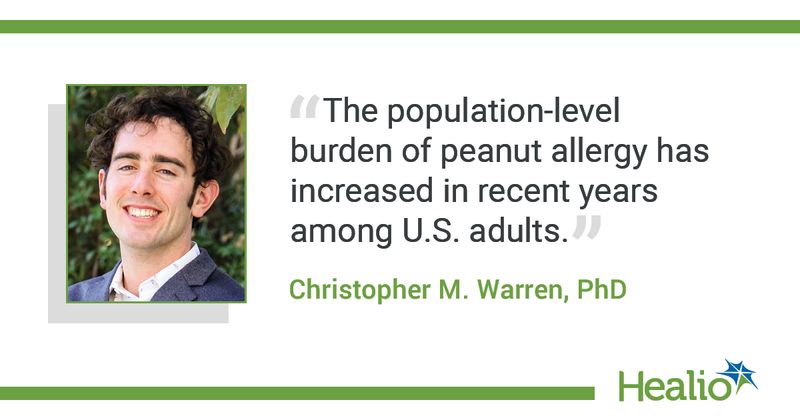Many patients with peanut allergy first report symptoms in adulthood
Nearly 3% of United States adults self-reported having peanut allergy, with 1.8% “having convincing peanut allergy,” researchers wrote in the Journal of Allergy and Clinical Immunology.
About one in six of these patients did not have allergy symptoms until they were adults, the researchers continued.

Christopher M. Warren, PhD, director of Population Health Research at the Center for Food Allergy and Asthma Research at the Northwestern University Feinberg School of Medicine, and colleagues analyzed “nationally representative complex-survey weighted data” for 40,443 U.S. adults that was collected during 2015 and 2016.
The results showed that the prevalence of current self-reported peanut allergy (PA) among U.S. adults was 2.9% (95% CI, 2.7-3.1). Of that number, 1.8% of the adults had “convincing PA,” which the researchers described as having symptoms to specific allergens that were aligned with an IgE-mediated reaction. Of the 2.9% with self-reported peanut allergy, 1.3% reported a convincing PA that was also diagnosed by a physician.
In addition, 17.5% (95% CI, 14.8-20.7) of the adults with PA reported their allergy began in adulthood. Of adults with PA, 54.7% (95% CI, 50.8-58.5) were non-Hispanic white and 55.6% (95% CI, 51.8-59.3) were women. The prevalence of PA was highest in those aged 30 to 39 years. The mean age for the first peanut reaction was 33 years among those with adult-onset PA and 6.6 years in adults with current, childhood-onset PA.
Warren told Healio Primary Care that a 2008 tally of self‐reported peanut allergy indicated less than 1% of U.S. adults had the condition.
“Clearly the findings of our more recent survey indicate that the population‐level burden of peanut allergy has increased in recent years among U.S. adults,” he said in an interview. “This may be partially explained by increasing prevalence of PA among the pediatric population during the past 2 decades and the fact that only roughly one in five children with peanut allergy are expected to outgrow their peanut allergy in adulthood. It also may be partially explained by the phenomenon of adult‐onset peanut allergy.”
The new findings should encourage primary care physicians to “assess any patient who states they have a negative reaction to peanut by taking a good history, testing and referring to an allergist,” Ruchi Gupta, MD, MPH, director of the Center for Food Allergy and Asthma Research at Northwestern University Feinberg School of Medicine and a coauthor of the study, told Healio Primary Care.
“If a peanut allergy is suspected, discuss management and when and how to use an epinephrine auto‐injector,” she added.
Gupta said the symptoms of peanut allergy — difficulty breathing, throat closing, hives, swelling, vomiting and a reduction in BP — “seem to be similar” among children and adults.

Gupta and Warren noted that there are no FDA-approved treatments for adults with PA who seek to initiate treatment in adulthood. Palforzia (Peanut [Arachis hypogaea] Allergen Powder-dnfp, Aimmune Therapeutics), a therapy for PA in children that was approved by the FDA last year, is only indicated for adults who started taking it before turning 18 years old, according to Warren. He said all other adults with PA may benefit from the “growing number of specialized private‐practice allergists offering oral immunotherapy.”

